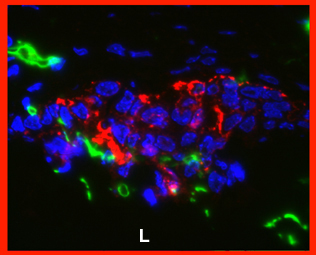
**This webpage was produced as an assignment for an undergraduate course at Davidson College**
Innate Immune Response
The innate immune system response is the first line of defense in both primary and recurring infections of herpes simplex virus (HSV). During this phase, the body attempts to control the viral load by inhibiting viral replication and also to initiate the adaptive immune response through cytokine and chemokine signaling.
Epithelial cells themselves create a physical barrier to HSV infection as well as an innate immune system barrier. HSV in the genital tract is presented with mechanical (i.e. mucus and bacteria) and secreted defenses, such as defensins and the complement system that can inhibit entry into epithelial cells. Viruses contain pathogen-associated molecular patterns (PAMPs), which are epitopes of microbial components. PAMPs allow the immune system to recognize the pathogen as an infectious agent, and receptors on the host cell surface (e.g. on macrophages) bind to PAMPs. Examples of PAMPs include lipopolysaccharide (LPS), peptidoglycan (PGN), and double-stranded RNA. The innate immune system dispatches neutrophils which recognize pathogens through PAMPs in order to engulf and destroy the pathogen (Janeway 2005). Once epithelial cells recognize PAMPs, they produce cytokines and chemokines that stimulate the adaptive immune response (Herbst-Kralovetz et al. 2006).
This response involves IFN-α, IFN-β, IFN-γ, NK cells, and macrophages (Whitley and Miller 2001). Interferons (INFs) are cytokines that cause cells to limit or prohibit viral replication, and they have a variety of functions in the innate immune response. They can control macrophage and NK cell activation, stimulate cytotoxic lymphocytes, induce cell surface costimulatory molecules, activate cytokine production, and stimulate local inflammation (Whitley and Miller 2001). IFN-α and IFN-β are produced by leukocytes and fibroblasts, and INF-γ is produced by CD4+ T cells, CD8+ T cells, and natural killer (NK) cells. IFN- α works to inhibit viral IE genes (Whitley and Miller 2001). INF-γ activates macrophages in the innate immune system response. When IFN-γ was applied to cells infected with HSV-1, the effects of MHC class I downregulation by HSV were reduced (Mikloska et al. 1996). Macrophages and dendritic cells (DCs) also engulf pathogens and present the antigen to cells in the adaptive immune response in addition to secreting cytokines and chemokines (Janeway 2005).
Another important facet of the innate immune response to HSV infection is the role of Toll-like receptors (TLRs) in activating complement. The complement system is a family of serum proteins that stimulates the opsonization and neutralization of antigen, and this system activates the adaptive immune response (Da Costa et al. 1999). TLRs are involved in PAMP recognition and are expressed by epithelial cells and antigen presenting cells. Ten TLRs have been discovered so far, and six of these are known to be involved in detection of virus particles. HSV interacts with TLR-2 at the cell surface and with TLR-9 with viral DNA inside the endosomes. When TLR-9 and HSV-2 interact, INF-α is produced at high levels (Cunningham et al. 2006). TLR-2 and TLR-9 are expressed by oral, ocular, and genital epithelial cells (Herbst-Kralovetz et al. 2006).
Cytokines and chemokines such as INF-α induce the activation of dendritic cells and macrophages (Herbst-Kralovetz et al. 2006). Dendritic cells, which are involved in creating mucosal immunity, are Langerhans cells in the epithelium and they serve as antigen presenting cells to T cells and activate the adaptive immune response (see Figure 1). Langerhans cells produce various IFNs, other cytokines, present MHC class II antigens, and work with cytotoxic lymphocytes in HSV-2 infection (Whitley and Miller 2001).

Figure 1. An epithelial cell infected with HSV-2 (red) and cell nuclei are blue. Langerhans cells (green) express MHC class II. "L" is the lumen of the vagina. Image from http://info.med.yale.edu/immuno/iwasaki/project1.html
Davidson College Biology Department
Contact jehodge@davidson.edu with questions or comments.